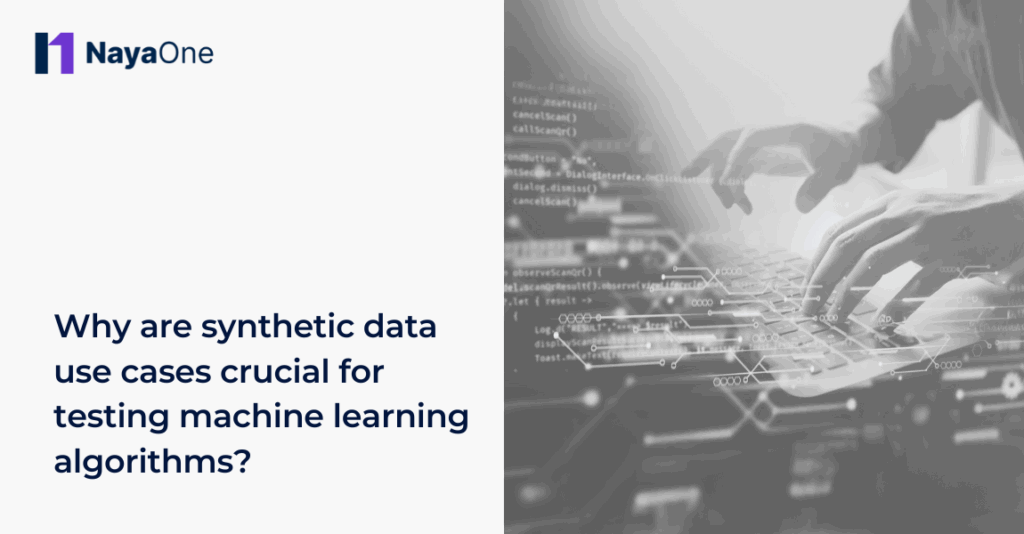Machine learning is changing the way businesses make decisions. From detecting fraud to automating customer service, machine learning algorithms are powering smarter solutions every day. But here’s the catch: testing these algorithms requires a lot of data, and often that data is sensitive, limited, or hard to get your hands on. That is where synthetic data comes in.
Synthetic data use cases are quickly becoming essential in the machine learning world. Instead of relying only on real data, which can be risky or incomplete, synthetic data creates artificial but realistic datasets that can be used for training and testing ML models. This helps companies develop better, safer, and more reliable algorithms without the usual headaches.
We will walk through why these use cases are so important for testing machine learning algorithms and how they help improve privacy, accuracy, and speed in development.
When you think about machine learning, you probably imagine huge datasets filled with real-world examples. But real-world data isn’t always perfect. It can be incomplete, biased, or even downright dangerous to use in certain situations. Synthetic data helps fill those gaps and provides a controlled way to test machine learning in a much more flexible and ethical manner.
How does synthetic data help tackle privacy and compliance challenges?
Many industries, especially finance and healthcare, have strict rules about how data can be used. Here, using actual customer data without proper controls can lead to serious legal problems.
Synthetic data use cases offer a neat solution. Instead of real personal information, synthetic data mimics the characteristics of real data but contains no actual customer details. This means companies can test their machine learning models in a safe environment without worrying about breaking privacy laws.
This approach allows organisations to access vast amounts of data without compromising personal information. Moreover, synthetic data helps bridge the gap between innovation and regulation. Data scientists can push the boundaries of what’s possible with machine learning, while compliance teams can rest assured that no sensitive data is at risk.
It also means companies can share data with partners, third-party developers, or auditors more freely. Since synthetic data contains no real personal info, it reduces risks while still allowing meaningful analysis and collaboration.
Using synthetic data makes it easier to follow regulations while still giving developers access to the variety and volume of data they need. It also helps avoid costly fines or reputation damage that can come from data breaches. This balance between innovation and safety is vital for today’s data-driven world.
In what ways does synthetic data improve machine learning model robustness?
When machine learning models are trained on only the data they have, they might miss some important patterns or biases hidden in real-world situations. This can lead to models that work well in the lab but fail in the real world.
Synthetic data use cases allow developers to create datasets that include rare or unusual scenarios which might not show up often in real data. For example, in fraud detection, synthetic data can simulate uncommon fraud patterns that are critical for the model to learn.
This expanded range of data improves model generalisation and reduces the risk of bias. Synthetic data can be tailored to ensure under-represented groups or rare events are adequately reflected, helping models perform fairly across diverse scenarios.
Using synthetic data also helps test model responses to “edge cases”, the weird or unexpected inputs that can trip up algorithms. If you only test your model with typical examples, it might fail when something unusual happens in real life.
By using synthetic data, machine learning teams can test how well their algorithms perform across a wider range of possibilities. This helps build stronger, more reliable models that are less likely to fail when faced with new or unexpected situations.
How can synthetic data speed up testing and development cycles?
Collecting and preparing real data for machine learning is a slow and expensive process. You have to gather the data, clean it, label it, and then hope it covers all the use cases your model needs to learn.
Synthetic data use cases change the game by letting teams generate exactly the data they need quickly. Need more examples of a rare event? Generate them. Want to test a new feature in your model? Create a synthetic dataset that matches those requirements.
This flexibility speeds up development by removing the waiting time for new data. It also makes it easier to test multiple versions of a model in parallel, helping data scientists improve accuracy faster.
Another benefit is the ability to iterate faster. When testing with real data, any gap or missing case means going back to collect more, which delays progress. Synthetic data removes that bottleneck, enabling continuous improvement and quicker deployment.
Furthermore, synthetic data can help simulate future scenarios that real data simply doesn’t contain yet. For example, if you’re preparing your machine learning model for a new market or customer base, synthetic data can help simulate those conditions so you’re ready from day one.
Synthetic data also helps reduce dependency on third-party data providers or external datasets, which can sometimes be costly or restricted. Generating your own synthetic data puts you in control, speeding up innovation without waiting on others.
Why is synthetic data important for testing scalability and operational readiness?
Deploying a machine learning model is not just about accuracy. The model needs to perform well under different conditions, including high loads and unexpected inputs.
Synthetic data use cases allow teams to simulate these real-world conditions in a controlled environment. They can create large datasets that mimic busy times or stress-test models by generating tricky edge cases.
Stress testing with synthetic data uncovers performance bottlenecks or vulnerabilities that might otherwise be missed. For example, a chatbot using machine learning can be tested with thousands of simulated users interacting simultaneously to see how it performs under pressure.
This kind of testing helps identify problems with performance, latency, or failures before the model is used in production. It also supports ongoing monitoring to make sure models stay reliable as data patterns change over time.
Scalability testing is crucial for companies expecting rapid growth or sudden spikes in user demand. These use cases make it easier to prepare for these scenarios and avoid unexpected downtime or failures.
By simulating real-world operational conditions, synthetic data enables teams to build machine learning solutions that don’t just work well in theory but also perform reliably day-to-day.
What strategic benefits do synthetic data use cases bring to machine learning?
Putting it all together, synthetic data use cases bring several strategic advantages for machine learning projects. They help solve the privacy dilemma, reduce bias, speed up testing, and ensure models are ready for the real world.
Beyond technical benefits, these use cases also open doors for collaboration. Different teams, from compliance to development, can work with the same datasets without risk. This improves communication and speeds up innovation cycles.
For companies looking to innovate with machine learning, these benefits translate to faster time to market, lower risk, and higher confidence in AI solutions.
At NayaOne, these use cases are an integral part of how we build and test machine learning algorithms. We use synthetic data to create realistic testing environments that protect privacy and boost accuracy. This approach helps us deliver AI solutions that are robust, compliant, and scalable.
By embracing synthetic data throughout the development lifecycle, NayaOne ensures our machine learning models are ready to perform at their best from day one, no matter the challenges ahead.






